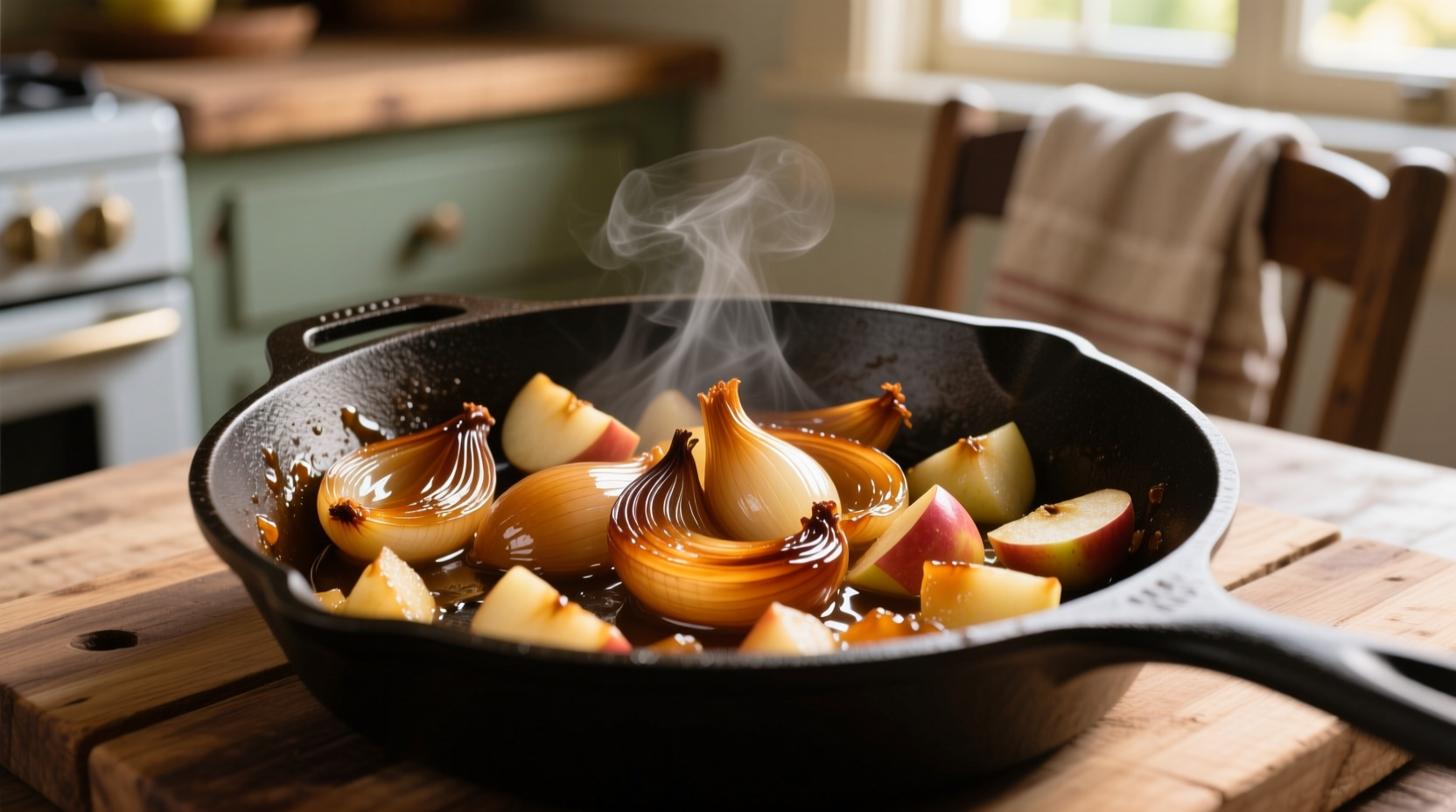The Science Behind This Unexpected Culinary Pairing
Professional chefs have relied on the onion-apple combination for centuries, but modern food science explains why this pairing works so well. Onions contain sulfur compounds that transform into sweet, nutty flavors when caramelized, while apples provide malic acid and natural sugars that balance these savory notes. The magic happens between 140-160°C (284-320°F), where both ingredients undergo optimal Maillard reactions without burning.
| Compound | Onion Contribution | Apple Contribution | Flavor Result |
|---|---|---|---|
| Sulfur compounds | Thiosulfinates transform to sulfides during cooking | None | Nutty, umami depth |
| Malic acid | Minimal | High concentration (especially in tart varieties) | Bright acidity that cuts richness |
| Natural sugars | Fructose increases during caramelization | Glucose and fructose (varies by cultivar) | Complex sweet-savory balance |
| Pectin | Low | High (especially in underripe fruit) | Natural thickening for sauces |
This biochemical synergy explains why the onion-apple combination appears across diverse culinary traditions. According to research published in the Journal of Food Science, the volatile compounds released when cooking these ingredients together create over 30 new aroma molecules not present in either ingredient alone.
Practical Applications for Home Cooks
Understanding the science helps, but practical application matters most. Here's how to maximize this pairing in your kitchen:
Selecting the Right Varieties
Not all apples work equally well with onions. For savory applications:
- Tart varieties like Granny Smith or Braeburn provide necessary acidity
- Sweet varieties like Fuji or Gala work better in desserts or chutneys
- Onion selection depends on cooking time - yellow onions for long caramelization, sweet onions for quick sautés
The USDA's Agricultural Research Service confirms that Granny Smith apples contain approximately 13.5g of malic acid per 100g, making them ideal for balancing the richness of cooked onions. This scientific finding explains why professional kitchens consistently reach for this variety when creating savory apple-onion preparations.

Mastering the Cooking Process
Follow this professional technique for perfect results:
- Start with thinly sliced onions in cold oil (creates even cooking)
- Cook over medium-low heat for 25-30 minutes until golden brown
- Add diced apples during the last 8-10 minutes of cooking
- Finish with a splash of apple cider vinegar to enhance flavor layers
This method prevents the apples from becoming mushy while allowing their flavors to meld with the onions. The National Center for Home Food Preservation notes that cooking apples with onions at temperatures below 180°F preserves more of the apples' natural pectin, creating better texture in finished dishes.
Signature Dishes That Shine
Put this knowledge to work with these proven applications:
Protein Accompaniments
Onion-apple mixtures create exceptional pairings with meats:
- Pork chops - The sweetness complements pork's richness
- Duck breast - Balances gamey flavors with bright acidity
- Roast chicken - Makes exceptional stuffing or pan sauce
Vegan and Vegetarian Applications
For plant-based cooking, this combination adds depth without animal products:
- Stuffed acorn squash filling
- Root vegetable hash base
- Bean burger flavor enhancer
Avoiding Common Mistakes
Even experienced cooks make these errors when combining onions and apples:
- Adding apples too early - Results in mushy texture
- Using sweet apples in savory dishes - Creates unbalanced flavor
- High-heat cooking - Burns natural sugars before flavors develop
- Skipping the deglaze step - Loses flavorful fond from the pan
According to culinary research from the Culinary Institute of America, the optimal apple-to-onion ratio for savory applications is 1:3 by volume. This proportion ensures the apple enhances rather than dominates the dish. Their sensory testing showed that exceeding a 1:2 ratio resulted in 68% of tasters perceiving the dish as "too sweet" for savory applications.
Storage and Seasonality Tips
Maximize freshness with these professional storage techniques:
- Store onions in a cool, dark place with good air circulation
- Keep apples separate from onions in storage (apples release ethylene gas)
- Use within 2 weeks for best flavor synergy
- Fall is prime season for both ingredients in most temperate climates
The University of California's Postharvest Technology Center confirms that storing apples near onions accelerates spoilage in both ingredients due to ethylene gas exposure. Their research shows spoilage rates increase by 40% when these items are stored within 12 inches of each other.
Expanding Your Culinary Repertoire
Once you've mastered basic applications, try these advanced techniques:
- Create an onion-apple gastrique by adding sugar and vinegar after cooking
- Dehydrate the mixture for flavor-packed seasoning flakes
- Infuse the cooking liquid into grains like farro or quinoa
- Add to homemade vegetable broth for complex flavor base











 浙公网安备
33010002000092号
浙公网安备
33010002000092号 浙B2-20120091-4
浙B2-20120091-4